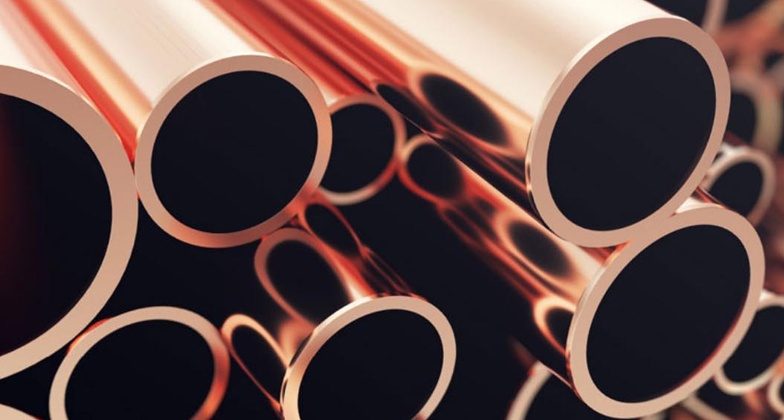
Copper C12210 is a type of copper alloy that is often used to make tubing due to its excellent thermal and electrical conductivity, corrosion resistance, and ease of fabrication. It is also known as phosphorus deoxidized, high residual phosphorus copper, or DHP copper.
Copper C12210 tubes are commonly used in various applications such as refrigeration, air conditioning, heating, and plumbing systems. They are particularly well-suited for applications that require high thermal conductivity and resistance to corrosion, such as in heat exchangers.
The properties of copper C12210 tubes make them ideal for use in harsh environments, such as those found in marine or industrial settings. They can also be used in potable water systems, as they are resistant to dezincification and can withstand high water velocities.
Overall, copper C12210 tubes offer a reliable and cost-effective solution for a wide range of applications where excellent thermal and electrical conductivity, corrosion resistance, and ease of fabrication are required.
For any requirement of copper C12210 tubes contact us today and we will get back to you with the best prices.
Specifications of Copper C12210 Tubes:
Here are some common specifications of Copper C12210 tubes:
Chemical Composition: Copper C12210 is a phosphorus-deoxidized copper alloy with a composition of 99.9% Cu, 0.015-0.040% P, and 0.04-0.12% Ag.
Size and Dimensions: Copper C12210 tubes are available in a range of sizes and dimensions, typically ranging from 1/8″ to 12″ in outer diameter and from 0.035″ to 0.125″ in wall thickness. The length of the tubes can be customized according to the specific application.
Physical Properties: Copper C12210 has a density of 8.94 g/cm3, a melting point of 1,083°C (1,981°F), and a thermal conductivity of 391 W/mK. It has good electrical conductivity, with a conductivity rating of 97% IACS (International Annealed Copper Standard).
Mechanical Properties: Copper C12210 has a tensile strength of 380-450 MPa (55,000-65,000 psi) and a yield strength of 165-205 MPa (24,000-30,000 psi). It has an elongation of 15-40% and a hardness of 70-120 HB (Brinell hardness).
Standards: Copper C12210 tubes are typically manufactured to meet various international standards, including ASTM B111/B111M, ASTM B359/B359M, ASTM B543/B543M, and EN 12451. These standards specify the requirements for the chemical composition, mechanical properties, and dimensions of the tubes.
We maintain a huge stock of Copper C12210 Pipes to meet our customers’ demand all over the world. We deliver all our copper pipes on time and safely. For the best prices of UNS C12210 Pipes Contact us today and our sales representative will get back to you.
Types of Copper C12210 Tubes:
There are several types of Copper C12210 tubes available, depending on their shape and application. Here are some common types:
Straight Tubes: Straight Copper C12210 tubes are the most common type and are used for a wide range of applications. They come in various lengths and diameters and can be easily cut and shaped to fit specific requirements.
Coiled Tubes: Copper C12210 tubes can also be produced in coiled form, which is ideal for applications that require a longer continuous length of tubing without any joints or connections. Coiled tubing is commonly used in refrigeration and air conditioning systems.
Finned Tubes: Finned Copper C12210 tubes have fins attached to their exterior surface, which increases their surface area and improves their heat transfer performance. Finned tubes are used in various heat exchanger applications, including air-cooled heat exchangers and oil coolers.
Capillary Tubes: Capillary Copper C12210 tubes are very small diameter tubes with a thin wall, typically less than 1mm in diameter. They are used in scientific and medical applications, such as blood gas analyzers and chromatography.
Special-Shaped Tubes: Copper C12210 tubes can be produced in various special shapes, such as square, rectangular, or oval tubes. These tubes are used in specialized applications, such as architectural metalwork, electrical conductors, and heat sinks.
Overall, Copper C12210 tubes are versatile and can be customized to meet specific requirements for various applications.
Applications of Copper C12210 Tubes:
Copper C12210 tubes are used in a wide range of applications, thanks to their excellent thermal and electrical conductivity, corrosion resistance, and ease of fabrication. Here are some common applications:
Refrigeration and Air Conditioning: Copper C12210 tubes are widely used in refrigeration and air conditioning systems as they have excellent heat transfer properties, are easy to bend and shape, and can withstand high pressure and temperature.
Plumbing Systems: Copper C12210 tubes are commonly used in plumbing systems for hot and cold water distribution. They are corrosion-resistant, non-toxic, and can withstand high water pressure and temperature.
Heat Exchangers: Copper C12210 tubes are used in various types of heat exchangers, including shell and tube, plate and frame, and finned tube heat exchangers. They are used to transfer heat from one fluid to another, making them essential in many industrial processes.
Electrical Conductors: Copper C12210 tubes are used as electrical conductors due to their high electrical conductivity. They are used in power generation, transmission, and distribution systems, as well as in electrical motors and transformers.
Architectural Metalwork: Copper C12210 tubes are also used in architectural metalwork, such as handrails, staircases, and decorative elements. They are valued for their aesthetic appeal, durability, and resistance to corrosion.
Overall, Copper C12210 tubes are an essential component in many industrial, commercial, and residential applications, thanks to their excellent properties and versatility.
OTHER GRADES OF COPPER TUBES
Pure Copper Tubes
Commercially available coppers have a total impurity content of 0.7%. They are incredibly ductile and soft. To make pure coppers more rigid, additional elements are frequently added. The diluted coppers will be assigned a UNS number ranging from C10100 to C13000 depending on the types and amounts of alloys and additives applied.
Oxygen Free Copper Tubes
The purest coppers are those that are oxygen free. They have the least number of volatile impurities and at the very least, contain 99.99% copper. Due to its frequent use in glass-to-metal sealing and transmitter tubes in high vacuum electronics, this form of copper is very conductive. It has the UNS identifier C10100 to C10200.
Electrolytic Copper Tubes
Copper that has undergone electrolysis-based refinement to produce tough pitch is called electrolytic copper. The metal can be processed using both hot and cold techniques. The UNS code for it is C11000.
Free-Machining Copper Tubes
Sulphur and telluride are added to free-machining copper to improve its machinability. All these elements will be added in about 0.5%. Copper that can be free-machined and contains sulphur is given the UNS C14700 designation, whereas copper that contains telluride is given the C14500 rating.
We are one of the India’s trusted manufacturer and exporter of UNS C12210 Tubing. We are exporting Copper C12210 Tubes globally. Our export countries includes:
United States, Mexico, Canada, Guatemala, Cuba, Haiti, Dominican Republic, Honduras, Nicaragua, El Salvador, Costa Rica, Panama, Jamaica, Trinidad and Tobago, Belize, Bahamas, Barbados, Saint Lucia, Grenada, Saint Vincent and the Grenadines, Antigua and Barbuda, Dominica, Saint Kitts and Nevis
Brazil, Colombia, Argentina, Peru, Venezuela, Chile, Ecuador, Bolivia, Paraguay, Uruguay, Guyana, Suriname, French Guiana, Falkland Islands
Russia, Germany, United Kingdom, France, Italy, Spain, Ukraine, Poland, Romania, Netherlands, Belgium, Czech Republic (Czechia), Greece, Portugal, Sweden, Hungary, Belarus, Austria, Serbia, Switzerland, Bulgaria, Denmark, Finland, Slovakia, Norway, Ireland, Croatia, Moldova, Bosnia and Herzegovina, Albania, Lithuania, North Macedonia, Slovenia, Latvia, Estonia, Montenegro, Luxembourg, Malta, Iceland, Andorra, Monaco, Liechtenstein, San Marino, Holy See
India, Indonesia, Pakistan, Bangladesh, Japan, Philippines, Vietnam, Turkey, Iran, Thailand, Myanmar, South Korea, Iraq, Afghanistan, Saudi Arabia, Uzbekistan, Malaysia, Yemen, Nepal, Sri Lanka, Kazakhstan, Syria, Cambodia, Jordan, Azerbaijan, United Arab Emirates, Tajikistan, Israel, Laos, Lebanon, Kyrgyzstan, Turkmenistan, Singapore, Oman, State of Palestine, Kuwait, Georgia, Mongolia, Armenia, Qatar, Bahrain, Timor-Leste, Cyprus, Bhutan, Maldives, Brunei
Australia, Papua New Guinea, New Zealand, Fiji, Solomon Islands, Micronesia, Vanuatu, Samoa, Kiribati, Tonga, Marshall Islands, Palau, Tuvalu, Naur
